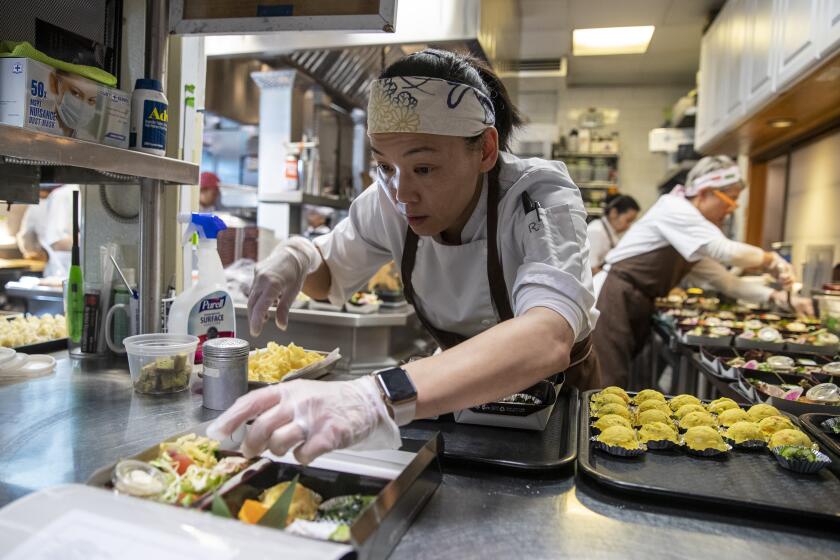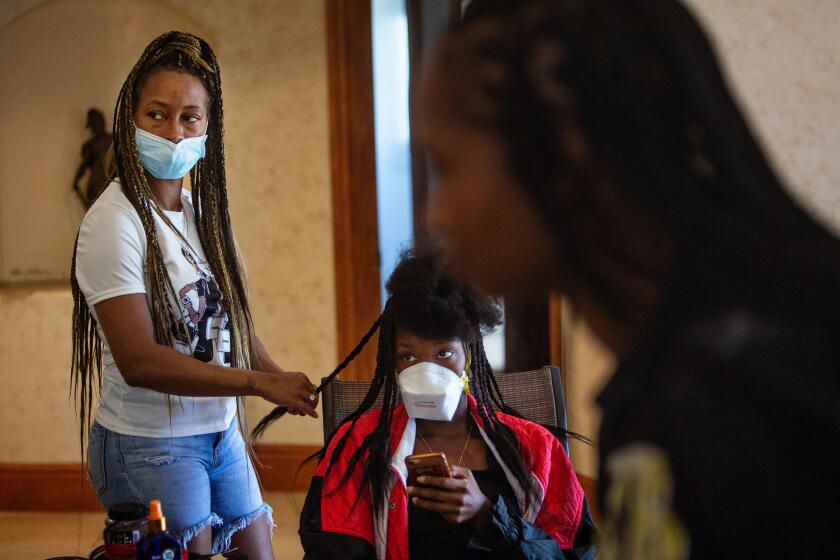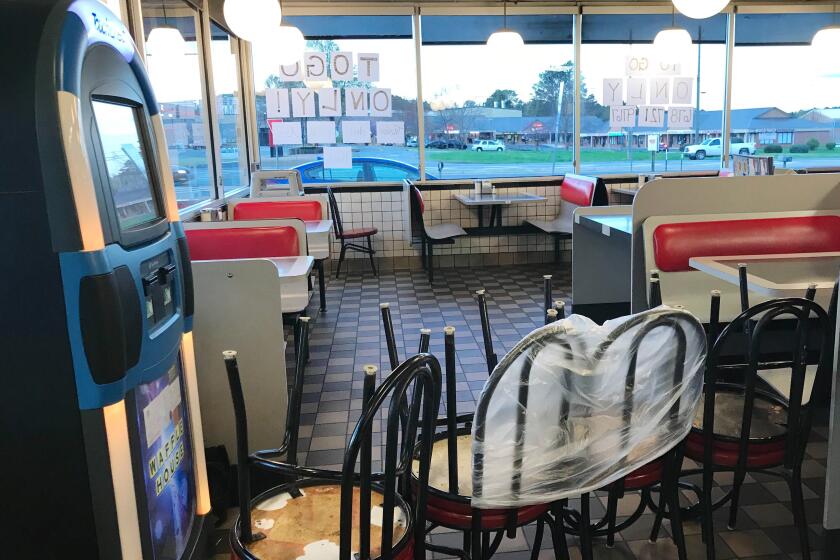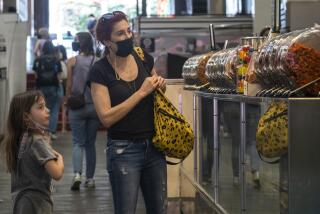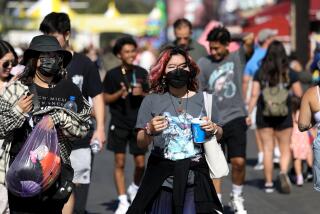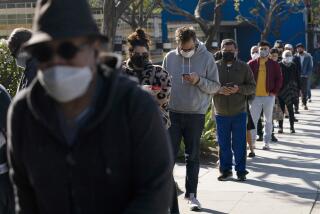L.A. County can reopen restaurants, barbershops, salons, Newsom says
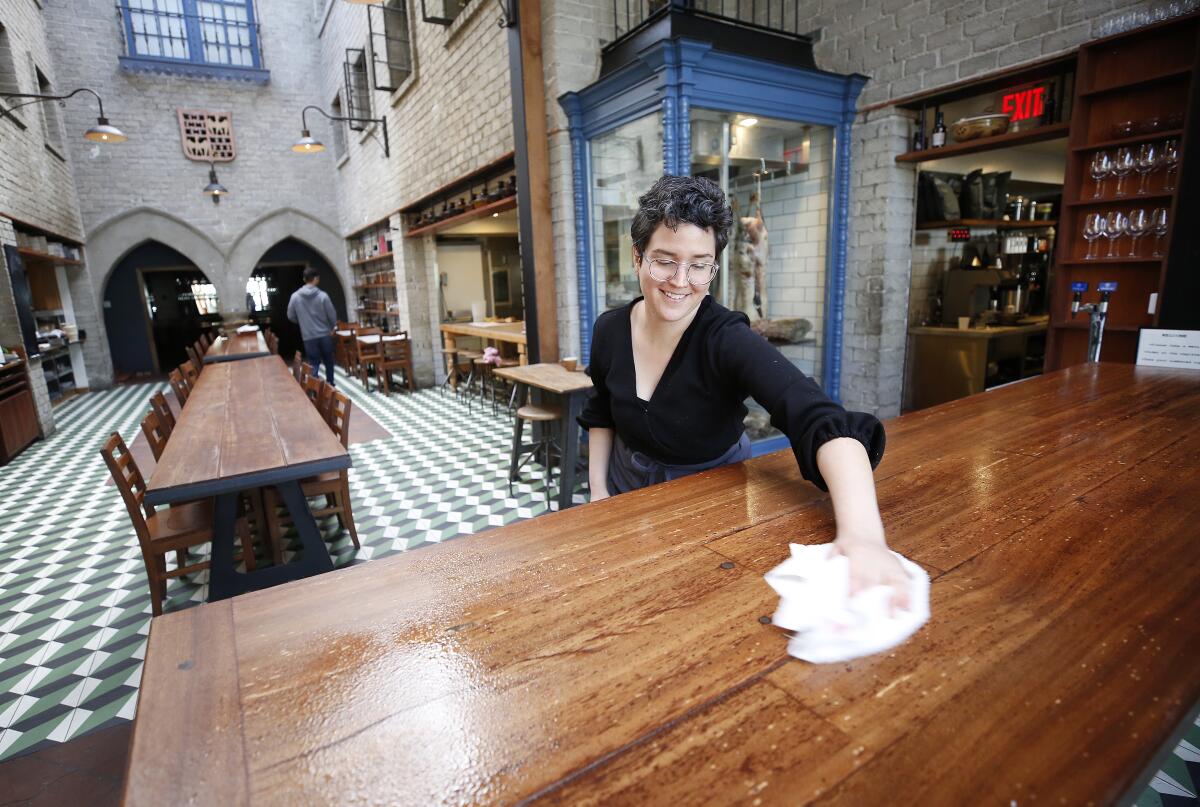
Los Angeles County on Friday received permission from the state to reopen restaurants for in-person dining, and resume services at barbershops and hair salons, marking a new phase in the region’s efforts to restart the devastated retail economy.
The move comes even though the county remains the epicenter of the coronavirus outbreak in California, with more than 2,200 deaths. More than half of all COVID-19 fatalities in the state have been in L.A. County, which has been slower to reopen than areas less hard-hit by the outbreak. The total number of confirmed infections in L.A. County is more than 50,000.
Gov. Gavin Newsom and other health officials said the county, despite continuing to see coronavirus deaths, is ready for this next phase, pointing to reduced hospitalizations, infection rates and increased testing capacity.
But it’s still a potential risk, and officials warned it could result in new outbreaks if social distancing and other safety rules are not enforced. Some health officials, notably Silicon Valley’s public health officer, have expressed concerns that California is reopening too quickly and the risk of more outbreaks is still too high.
With the L.A. County shift, restaurants, barbershops and hair salons will be able to reopen as early as this weekend, provided they can meet the county’s guidelines and safety protocols, officials said.
“This is a fine line that we’re walking in the county of Los Angeles,” County Supervisor Janice Hahn said Friday. “We are threading the needle between keeping the public safe and allowing our economy to reopen.”
She said that officials have been working with the county’s Economic Resiliency Task Force, which includes experts from a variety of sectors, including the restaurant industry, to develop a detailed safety plan for in-restaurant dining. The plan includes diagrams showing how to separate tables six feet apart and proposes putting physical barriers between tables where such distancing isn’t possible, Hahn said.
As those plans suggest, things won’t immediately return to business as usual for the newly reopened establishments.
County public health officials are expected to announce restrictions on operations, including a 60% capacity limit for restaurants.
“Many of them will have to find creative ways to do that by utilizing their parking lots and the streets in front of their restaurants,” Hahn said.
With restaurants banned from serving dine-in customers, even high-end restaurants are pivoting to takeout.
Effective immediately, restaurants, barbershops and hair salons are permitted to reopen within the city of Los Angeles as long as they follow official guidelines, Mayor Eric Garcetti announced at a news conference Friday.
Barbers and hair stylists can only take one client at a time, and both the stylist and client must wear face masks. Nail salons and spas will remain closed for the time being, the mayor said.
Because it will be a struggle for restaurants to maintain distancing guidelines and remain profitable, the city has launched a program called “L.A. Al Fresco” that relaxes the rules for outdoor dining so customers can eat at tables set up on sidewalks and private parking lots, the mayor said. He added that businesses will be immediately approved if they apply.
“Businesses are not mandated to open,” Garcetti said. “So if you’re a business owner, take your time to get it right.”
Office businesses can also reopen, but only if teleworking from home is not possible, the mayor said.
Other county communities, including San Pedro and Long Beach, are similarly preparing to close streets to traffic and expedite permit variances so restaurants can put more tables and chairs outside.
Both restaurants and salons are expected to be required to keep detailed records of customers, including contact numbers, so public health officials can quickly follow up with patrons in the event of an outbreak.
Environmental health inspectors will be out inspecting and providing guidance to newly reopened establishments, but the businesses are not required to undergo an inspection before they resume services, Barbara Ferrer, the county health director, said Friday.
“As we enter the weekend and we are out of our homes and visiting many of the reopened establishments because we’re all really hungering for some return to normalcy, I want to just note that the new normal that you’re going to see reflected in the businesses reflects the fact that COVID-19 is still very active in our communities and there’s a great deal at stake in the reopening,” she said.
She said that it continues to be crucial for people to practice physical distancing, wear a cloth face covering and stay home if they’re feeling sick.
“We do again want to note that the actions we take now are essential to making sure that people don’t become seriously ill, we don’t overwhelm our hospitals and we save people’s lives,” she said.
“It’s never been more important for businesses, individuals and institutions to use the tools that we have available to take care of each other and to continue to slow the spread of COVID-19.”
Earlier this week, the county reopened shopping malls, many retail businesses and churches with strict social distancing rules. But reopening restaurants and personal care businesses is considered a bigger step forward because both are considered higher-risk than typical stores.
L.A. County joins the vast majority of other counties in California to reopen restaurants and hair salons with social distancing rules.
In black communities, where barbershops and salons are cultural institutions and gathering places, the lockdown has hit barbers and stylists hard.
Restaurateurs and other business owners had mixed reaction to the news Friday.
“I don’t think we’re going to scramble to open,” said Jon Yao, chef-owner of Kato in West L.A. “I think our timeline is going to be more in line with how we combat the disease instead of what the city says is OK.”
Some establishments expressed concern with the pace of the reopening.
“Personally I think it’s all a disaster,” said Josiah Citrin, chef-owner of restaurants including Charcoal, Dear John’s and Melisse. “It all went too fast; nothing’s been smartly done.”
Citrin said he plans to reopen Charcoal, his steakhouse in Venice, on Thursday. But things will look remarkably different: Instead of as many as 110 diners spread across booths, a communal table and the bar, he’s limiting capacity to 40 diners at a time, all at their own tables.
He has removed the bottles of steak sauce, chimichurri and barbecue sauce that used to remain on tables all day. No walk-ins will be allowed. Instead of 56 employees, he’ll have about 35.
The rush to reopen Charcoal, he said, is because the money he received from the federal PPP loan “is almost out.”
“I followed the rules, and I have almost no money,” he said. “I have a couple weeks left.”
He figures going to a restaurant is safer than shopping at a crowded grocery store and believes diners will return after being cooped up for so long.
“If cases start spiking and it gets really bad, then maybe people won’t go out,” he said. “But for now, what else can you do? You can’t go to a movie, you can’t go to a concert, you can’t go to a sporting game, so restaurants will be in pretty high demand.”
Still, with only 40 diners max at a time, he’s bracing for a significant revenue hit.
“It’s going to really hurt my bottom line. From now until this is over, it’s not about making money, it’s about surviving. It’s about finding ways to see another day.”
Johnny Ciccone, 42, owns Headbetter, a hair salon in Sherman Oaks that had eight chairs, four worked by employees and four worked by stylists who rented their space. It has been closed for the past 2½ months.
“We’ve just been decimated by this,” he said.
Even with the plans for reopening, Ciccone fears that as many as half of the city’s hair salons are still destined to fail. “The only reason I’m still able to hang out at my salon is because there has been a moratorium on evictions. I did receive PPP funding but that was six weeks in and I haven’t been able to pay anyone or bring them back to work,” he said. “For a lot of salons, it’s going to depend on the landlords. Are they willing to make deals? Maybe my landlord will make a deal with me, maybe not.”
Ciccone was told to close March 15. Prepandemic, Headbetter would see 25 to 30 customers a day. Ciccone estimates he will be able to serve about half that number under the new guidelines. Even as he talked about the reopening, workers were removing four of his eight chairs, in order to comply with the new spacing requirements. Ciccone added that it wasn’t as if he could just reopen and conduct business as usual — he must provide everyone with hand sanitizer, screen people for fevers before they enter and require both employees and clients to wear masks.
“One of the biggest changes is that there are not going to be any walk-in services,” he said. “Customers are going to have to wait outside until we are ready for them.”
He said he’s purchased thousands of masks and gloves and gallons of disinfectant and rubbing alcohol, as well as new point-of-sale card readers.
Even signage will require another outlay of money, Ciccone said. “The city has released sample signs, requiring social distancing, hand washing and other requirements, how we are going to be operating safely,” he said. “We have to have all that posted, so I’ll be dealing with that this weekend.
“For a small business like mine, we have spent a few thousand dollars getting ready for the reopening, changing chair layouts, other things.”
In spite of all this, Ciccone said, “I don’t think we are going to pass this on to our clients, especially if they have faced unemployment. They are going to have wait longer to get appointments. These are people I have a close relationship with. They have been going through the same tough times I’ve gone through.”
Anre Anduha, 35, who owns Brotherhood Barbershop in Sherman Oaks, said he’s also taken on a lot of debt.
“I’m $15,000 in debt now when I consider rent, my $400 to $500 DWP bills, cable bills and that’s not even counting the lost income,” he said. “When I open back up, I’m only going to be using four chairs.”
Before COVID-19 struck, Brotherhood Barbershop was always busy with appointments and walk-ins, averaging between 75 to 100 customers a day. It’s been closed since March 19.
Anduha also faces additional expenses, such as capes, “for every single client that comes in, instead of many switching capes two or three times in a day.”
Also, by contrast, hair salons do not typically rely on walk-ins for a significant slice of their business. That’s not the case with barbershops, which do rely on them. Anduha said that half of his business were people who just walked in, hoping to quickly find an empty chair and willing to sit around inside the shop to wait, which will not be allowed now.
“It’s supposed to be appointment only now,” said Anduha, who was already thinking about workarounds, depending on the peace of mind of the particular barber, especially if dealing with strangers. “Barbers may want to take a client’s temperature, ask whether they have been traveling. For the majority of those, we’d probably just write down their information, ask them to wait outside in case a chair opens up. You can’t just say ‘come on in, sit in a chair’ like we used to.”
In spite of being in debt, he was just as reluctant as Ciccone to raise prices as substantially as circumstances might warrant, noting that his customers have also suffered from issues such as lost work and income.
“Do I think I will survive? I really don’t have another option. I’ll have to. But we were already at a decent price level at $40 a cut,” Anduha said. “We might go to $45, but I’m not going to raise prices a lot right away.”
L.A. County submitted its variance application on Wednesday to the state, which decides whether counties can reopen at an accelerated rate if they meet certain COVID-19 benchmarks.
“I think the only reason that we felt comfortable asking the governor for a variance was because we have flattened the curve and we have not ever seen that spike and that surge in cases we were predicting a couple months ago,” Hahn said Friday. She noted that the county’s hospitals and intensive care units never reached capacity and the healthcare system did not become overwhelmed.
Still, she said, officials will monitor metrics to quickly identify and respond to any potential spike in cases.
“We know that with every part of the economy that we look to reopen, we’re talking about millions of people who now might be venturing outside to do something new and different,” she said. “So of course we’re going to keep a watchful eye on this and pay very close attention to the cases.”
Newsom, who established the variance process earlier this month, has cautioned residents that although businesses across the state are starting to reopen, the threat of the coronavirus is not over.
In its application to the state, L.A. County officials make the case that the county has met the criteria created by the California Department of Public Health to reopen.
For example, Los Angeles County had to prove that the prevalence of COVID-19 cases is low enough that, if the stay-at-home order is eased and cases undoubtedly increase, the county will have the capacity to respond.
The county reported a decline in its total number of hospitalized patients, a seven-day average of daily percent change of -1%, according to the variance application.
L.A. County also had to prove that the prevalence of the coronavirus spreading in the community was low enough to reopen. The state’s criteria is: fewer than 25 new cases per 100,000 residents in the past 14 days, or less than 8% testing positive in the past seven days.
L.A. County was able to meet the latter, with 6.5% people testing positive in the past seven days, according to the variance application. Meanwhile, the county saw almost 100 cases (98.7) per 100,000 people in the past 14 days, four times higher than the state’s criteria.
One of the more concerning portions of the county’s application related to showing that nursing homes are prepared should the COVID-19 pandemic intensify.
As of Tuesday, only 33% of the 381 nursing homes in L.A. County had enough personal protective equipment to last more than 14 days, according to the application. Less than half, 47%, have enough N95 masks to last two weeks, and only one-third have adequate gowns.
Much of the country remains unlikely to venture out to bars, restaurants, theaters or gyms anytime soon, a new survey shows.
Dr. Christina Ghaly, director of health services for L.A. County, said last week that at the start of the coronavirus outbreak, every one person who contracted the virus infected more than three others. After the stay-at-home order was issued, that rate of transmission dropped to 1 — every person who contracted the virus infected only one other.
But, Ghaly warned, that number could rise again if the use of face coverings and social distancing practices do not continue.
For the past four days, the number of hospitalizations in L.A. County has remained relatively unchanged from 1,440 to 1,477 people in hospital care, and between 28% and 27% in intensive care. The county has also reported for the past four days that 8% of those who have been tested for the virus have been positive.
In the application to the state, the county included a draft of its community mitigation plan, which outlines how the pandemic could play out in the coming months in Los Angeles County.
According to that mitigation plan, completed May 15, health officials anticipate additional waves of cases at varying levels of severity will occur over the next 18 to 24 months throughout the U.S., including Los Angeles County, and will continue until enough people — at least 60% to 70% of the population — are immune to the virus.
“Extraordinary and historically unprecedented efforts have resulted in disease transmission slowing in Los Angeles County,” the plan reads. “However, its future course is still highly unpredictable.”
Dr. Sara Cody, health officer for Santa Clara County and a key architect of the nation’s first coronavirus shelter-in-place order, this week criticized California’s increasingly fast pace of lifting stay-at-home restrictions.
Cody expressed concerns that California risks a surge in cases if it reopens too many sectors of society too quickly. Reopening so fast, she said, means there isn’t enough time to implement new procedures to make reopened activities safe.
Since early May, “the state has shifted away from the stay-at-home model and has made significant modifications with increasing frequency,” Cody said. “The pace at which the state has made these modifications is concerning to me.”
Health experts have made the same point.
“Without having social distancing, we are going to definitely see some increased spikes and transmission occurring. That’s definitely going to happen,” said Dr. Robert Kim-Farley, epidemiologist and infectious-disease expert at the UCLA Fielding School of Public Health.
Times staff writer Colleen Shalby contributed to this report.
More to Read
Sign up for Essential California
The most important California stories and recommendations in your inbox every morning.
You may occasionally receive promotional content from the Los Angeles Times.
